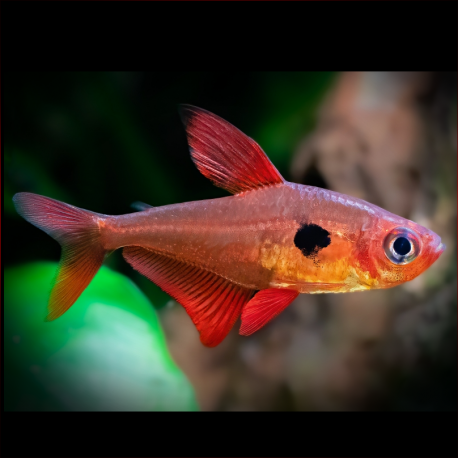More info
Datasheet
| Minimum Tank Size | 96 litres / 25.36 US gallons |
| Maximum Size | 3.5cm / 1.38inches |
| Temperature | 20°C / 68.00°F - 28°C / 82.40°F |
| Hardness | 1.01dgH / 18ppm - 12.05dgH / 215ppm |
| pH | 4.5-7.5 |
General Description
The Red Phantom Tetra, scientifically known as Hyphessobrycon Sweglesi, is a small, popular aquarium fish species with vibrant coloring. It is commonly bred commercially, with wild specimens being scarce in the ornamental trade. There are multiple color forms of this tetra, with one standout 'red' or 'var. rubra' variant that retains its bright red pigmentation in captivity, potentially influenced by its collection locality's conditions. This species can be identified by certain morphological features and characteristics, such as body depth, teeth structure, and fin shapes.
Aquarium Setup
To maintain Red Phantom Tetras in captivity, it is recommended to house them in a well-researched community aquarium alongside various compatible species. These tetras thrive best when kept with similar-sized characids, gasteropelecids, lebiasinids, smaller catfish species, and non-predatory, small-to-medium-sized cichlids. Acquiring a mixed-sex group of at least 8-10 individuals is advised to observe more engaging behavior, as males form dominance hierarchies and compete for female attention, displaying enhanced coloration in larger numbers.
Behaviour
The Red Phantom Tetra is recognized for its peaceful nature, making it a suitable addition to community aquariums. These tetras exhibit temporary dominance hierarchies within their groups, showcasing interesting behaviors when maintained in numbers. Additionally, they engage in mating displays, with males vying for female favor through coloration and behavior.
Feeding and Diet
In their natural habitat, Red Phantom Tetras are likely omnivorous, feeding on small invertebrates, crustaceans, algae, and fallen fruits. In aquarium settings, they can survive on dried foods but thrive on a varied diet that includes live and frozen foods like bloodworms, mosquito larvae, Daphnia, and Moina to ensure optimal health and vitality.
Reproduction & Dimorphism
These tetras are egg-scattering free spawners displaying no parental care. To encourage breeding, a separate breeding tank with mature water, dim lighting, and suitable spawning substrate is recommended. Adult males develop elongated dorsal and anal fins, while females have a deeper body shape, showcasing sexual dimorphism within the species.
Habitat and Distribution
The Red Phantom Tetra is endemic to the upper and middle Río Orinoco watershed in Colombia and Venezuela, predominantly inhabiting minor tributaries, oxbows, and flooded forest areas. They are often found in habitats with clear water, sandy substrates, and dense aquatic vegetation, such as morichals. These tetras thrive in blackwater and floodplain environments, coping with extreme flooding during the rainy season in their natural habitats.
Ensure aquarium water conditions are maintained within a hardness range of 18-215ppm, a pH of 4.5-7.5, and a temperature between 20-28°C to replicate their native environment effectively. It is also recommended to set up the aquarium with sandy substrate, driftwood, live plants, and leaf litter to simulate their natural habitat and provide suitable cover for the fish.

